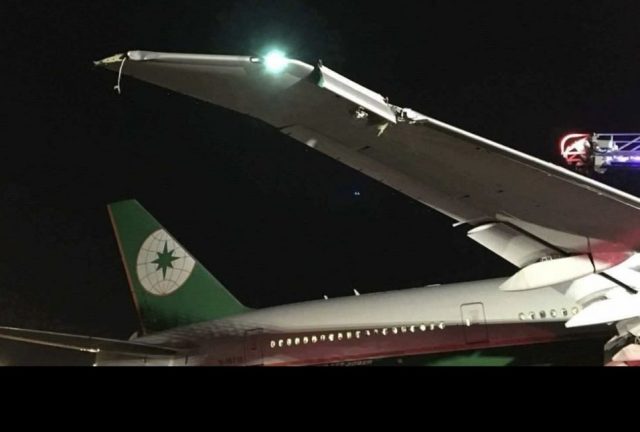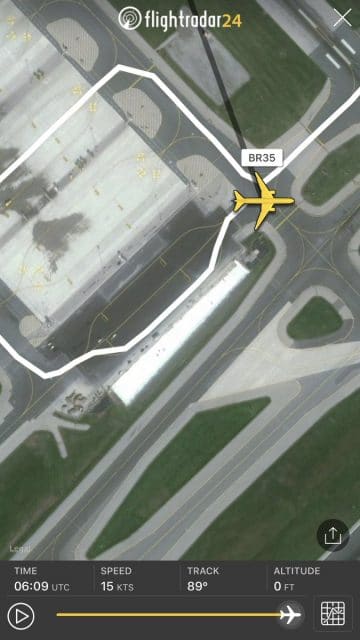Ground to EVA35, Apparently You Hit a Pole
Earlier this week there was a bit of a fender-bender at Toronto Pearson International Airport.
EVA Air flight 35 was a scheduled flight from Toronto departing at 00:45 am local time for a 16 hour flight to Taipei. The aircraft was a Boeing 777-300 B-16718.

It was early morning and dark at Toronto, although the lights were on and the ground was clear of snow. The aircraft was cleared to taxi out of the Central De-Ice Facility via Taxiway Victor and changed frequency to Ground Control.
As they were exiting the de-icing area, Ground contacted EVA 35 to say that de-icing staff had reported that the aircraft was not on the centre-line of taxiway Victor, which the flight crew acknowledged. A moment later, Ground called back to say that they had apparently hit a pole.
You can hear the entire exchange here on this LiveATC recording.
| Ground: | EVA 35 the central de-ice staff says you’re not on the centre-line of [taxiway] Victor, there. |
| EVA35: | Uh…we see the white centre[line] so we’re a little bit left and try to going to the right again–uh, left. Left again. |
| Ground: | OK, just use caution as you taxi at Echo and Delta and would you come up on [Toronto Tower] 118.7 |
| EVA35: | EVA35 (confirmed) |
| Ground: | EVA35…Apparently you hit a pole. |
| Ground: | EVA35 please stop there |
| EVA35: | Stop somewhere? |
| Ground: | Stop! |
| EVA35: | OK |
| EVA35: | You mean [on] the right side [was] a pole? |
| Ground: | Yes, you hit the pole on the right side. I’m just going to call some trucks to come have a look. |
| Ground: | EVA35, I called some trucks to come and have a look. Apparently the people in the CDF said that you hit a pole on the right side of the aircraft. |
| EVA35: | OK. We didn’t feel we hit a pole, just feel the rocking(?) of the aircraft. We didn’t… because the judgement should be OK. Anyhow, just check, thank you. |
It carries on for some time as they dispatch vehicles to the de-icing facility to take a look. The hope in the voice of the flight crew is kinda heartbreaking.
| EVA35: | Can you check our aircraft is OK? We didn’t feel the aircraft touch anything and just a little bit shimmy because the taxi[way] I saw… maybe the rough surface? |
| Ground: | …EVA35 there’s going to be some more vehicles who will be able to have a better look. |
| EVA35: | OK. Can you just check on my [unintelligible] right wingtip? |
The answer was yes, the right wing had in fact collided with a lamp post.

Fire engines were dispatched and the 238 passengers (and two infants) were evacuated and then watched from the sidelines.
Was on same flight. Video of YYZ fire services untangling pole lamp from EVA 777 wing. Wonder if that's ever been said before? pic.twitter.com/tIoQm3nRk5
— Marc MacDonald (@flight2fancy) December 3, 2017
An intriguing question is how the flight crew didn’t notice that they’d collided with the pole. Reports from the back of the plane differed. One passenger said he felt’two BIG bumps’ and claimed someone else had reported sparks from the pole being dragged. Another said they only felt two vibrations before the aircraft stopped.
The pole was knocked over on impact and one report said that the aircraft continued travelling with the lamp itself embedded in the wing. If this is correct, then it seems like the Boeing had probably already struck the pole by the time someone noticed they were off the centre line.
How they went wrong seems a little bit clearer. Aviation photographer Tom Podolec points out that the flightradar24 track shows the route they took from Bay 3.

If you look at their route, you’ll see they turned right to follow the taxiway along the edge. Looking just a bit up from them on the map, you can see Taxiway Victor going straight through. This is the route that a wide-body like the Boeing 777 should take.
Following the right-hand lane took them too close to the lights, even if they were right on the centre-line.
Toronto Pearson airport was also the location for the wingtip collision last Sunday so if you are flying in or out of there, please be careful on the ground!









I am of course not familiar with Toronto and the biggest aircraft that I have flown was the BAC 1-11, so I am not really qualified to give any comment other than some general remarks.
But it would seem strange to me that at a major airport ANY aircraft following the centreline of a taxiway, and being only marginally off the centre, should strike an object like a pole.
Which leads to the question: had the airport taken adequate precautions to prevent such an incident?
Was this mentioned in AIP / Jeppesen charts? Like a note on the charts mentioning that a particular turn would be limited to aircraft below a certain size – or not available a all? Were the crew made aware of the taxi route, in other words had they been issued their route by ‘ground’ and read it back correctly?
Were warning shields posted at or before the intersection and, if so, were they sufficiently visible, like clear of snow?
At Irish airports the way jurisdiction had developed, for a long time and certainly in the ‘eighties, It had something to do, I believe, with the history when Air Linte and Air Rianta were split into separate entities. Anyway, Aer Lingus were in a position of virtual control over the ground movement areas.
Ground vehicles, if they were painted green, were barely under control of any authority. I myself was once confronted with a situation where I narrowly avoided an Aer Lingus ground vehicle and was told by ATC that they had no control over it because “it was Aer Lingus”. This situation has long since been rectified, but I remember that an Aer Lingus vehicle collided with a parked Ryanair BAC 1-11 at Dublin It was a small truck, the bed held a sizeable generator. It probably took a turn on the apron too fast and struck a wingtip.
The force of the impact displaced the nose of the 1-11 about a meter sideways, and I believe WITH THE TOWBAR AND TRACTOR connected !
It took a week to repair the 1-11.
The truck had to be written off.
Rudy — Google Earth shows the area on the radar track; it’s WSW of the approach end of 33R. When I zoom in on the area shown above, the scale suggests they were ~40 feet off the proper track; effectively they were on a siding rather than the main line. (I can even see the shadow of the light they may have clipped.) I can’t figure out why the taxi line splits in that area; the deicing areas all have split lines (maybe so they can deice a smaller plane on each side of each bay?), but the area where this plane went wrong doesn’t look suitable for deicing. Note that the lines going out of the split are clearly labeled 1{N,C,S}
Are there any general rules about what pilots should do when they reach a 3-way split in a guide line? I would think the default would be to take the middle (suggesting this mess was pilot error), but I don’t know whether such splits are common enough to have a general rule.
Chip,
I am not sure either. My comments are usually straight “off the cuff”, mostly I comment based on my own 40 years as a commercial pilot.
Accuracy may suffer on occasion, I leave that to people who are more diligent in digging up and checking the facts and fine print.
I stopped flying in 2009. My ATPL had reverted to the status of PPL on age grounds.
So I have been out of flying for a long time now.
What I do remember that on airports with a fixed de-icing base there were extensive instructions and explanations on the Jeppesen charts.
Things have changed now, we carried volumes of thick leather bound manuals – plus a smaller one, the route manual. KLM had (perhaps still do) their own system. Far superior to Jeppesen but of course tailored to the airline’s own operations so not very suitable for general aviation.
(I am not suggesting that Jeppesen are not good, they just have to cater for every type of operation, every size and category of airplane AND cover every angle so that they cannot be held liable. An in-house system does not have these problems).
The “Jeppy” had a system where the charts numbering referred directly to the contents, so “10” and its sub-divisions referred to airport ground operations.
Paris Charles-de-Gaulle used to have a large de-icing bay in the centre of the airport. It could take a long time, lining up in the queue and if there were long delays for take-off (not impossible in bad weather with snow and ice) it could happen that the hold-over time had expired before the flight could get take-off clearance.
Later, the de-icing gantries were moved to just before the holding points..
I only used the de-icing facility once at Paris and I do seem to remember that Jeppesen contained extensive and very clear (for experienced crews anyway) instructions about the procedures.
So if there is / was a split in a taxiway system, I suspect that it would have been mentioned somewhere in the Jeppesen charts. But even those manuals are now carried as ballast, the “hard copy” is there for legal reasons and in the event of a failure of the electronics. The plates can be superimposed on a screen, showing the desired track in the actual environment – or in whatever way the crew selects.it.
Very different from the “good ole’ days, but it does create new potential pitfalls of its own.
On a funny note: In winter we carried a large, pressurized drum with a hose and a spray nozzle. in the Citation. It had a harness like a back pack. It was designed for weed killers but we had de-icing fluid in it.
Pre-mixed with warm water, it allowed us to repeat the de-icing at the holding point if necessary: Left engine shut down, aircraft de-pressurized, door open and quickly give the wings and tail an extra spray. We used this once, if I remember correctly in Scandinavia.